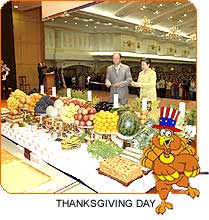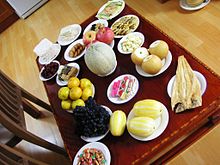Thanksgiving Day Celebration!
Korea
September 22
HISTORY
Historically and according to popular belief, Chuseok originates from Gabae. Gabae started during the reign of the third king of the Kingdom of Silla (57 BC – AD 935), when it was a month-long weaving contest between two teams.
Come the day of Gabae, the team that had woven more cloth had won and was treated to a feast by the losing team.
Korean traditional instrument, Gayageum was appeared in Silla Kingdom(57 B.C.-935 A.D.). It has represented as women’s instrument for a long time since it is good for expressing women’s sentimental feelings. Also, many literary men and old entertainers loved to play it. Gayageum was in the center of the elegant society of Silla and Joseon dynasty.
Still many Koreans love it. This instrument is played by tuming twelve strings. It has its own Korean sound. There are many songs revealed its characteristics well. They need technical accomplishment and fastness. Gayageum is considered as the representative instrument which opened the new generation of traditional music. Nowadays many players make creative songs. Some of them change the structure of Gayageum or the number of its strings. It has 12 strings originally but now there are fifteen, seventeen, and twenty one strings, etc.
According to Yoon-soo Kang, Reporter
Many scholars also believe Chuseok may originate from ancient shamanistic celebrations of the harvest moon.New harvests are offered to local deities and ancestors, which means Chuseok may have originated as a worship ritual.In some areas, if there is no harvest, worship rituals are postponed, or in areas with no annual harvest, Chuseok is not celebrated.
Traditional Customs
Another table with many traditional food offerings on it.
In modern South Korea, on Chuseok there is a mass exodus of Koreans returning to their hometowns to pay respects to the spirits of one’s ancestors. People perform ancestral worship rituals early in the morning. They often visit the tombs of their immediate ancestors to trim plants and clean the area around the tomb, and offer food, drink, and crops to their ancestors. Harvest crops are attributed to the blessing of ancestors.
One of the major foods prepared and eaten during the Chuseok holiday is songpyeon (송편), a crescent-shaped rice cake which is steamed upon pine needles.
Other foods commonly prepared are japchae, bulgogi and fruits.
Folk Games
A variety of folk games are played on Chuseok to celebrate the coming of Autumn and rich harvest. Village folk dress themselves to look like a cow or a turtle, and go from house to house along with a Nongak band playing music.
Other common folk games played on Chuseok are tug of war, ssireum, archery and gama fighting. Folk games also vary from region to region.
Chuseok is one of the biggest celebration in Korea.
Chuseok means thanks giving. it just a little bit same with western culture. however, chuseok is celebrating harvest season. the other name of Chuseok is hangawi which means han is big and gawi is middle. So, hangawi is big middle. Actually, that festival is in the middle of eighth month in lunar calendar. as time goes by, the name is change become Chuseok. Chu is from Chinese character which means autumn.
Ritual when Chuseok
Because of chuseok is a harvest festival, so all the farmers enjoy their works. they eat their corps together. Then, the day before chuseok, usually they come to clean up their ancestors’ grave, we call it beolcho (벌초). ( Today, this refers to ‘weed clean up’ for the autumn.)
“In modern time, like now, the tradition is a bit changing as all the people who live far away from their hometown, they come back to their hometown. Because of them, traffic jams are everywhere. the road is full of cars; they want to celebrate chuseok with their big family. ” says an average Korean girl in these times.

On Chuseok Day,
all family wear their new clothes and even shoes.
Girls prepare for the ritual to ancestor, like rice cake, liquor and fruit. furthermore, they prepare table which is full of food. but we have to put it by following some rules. first, put fruit in the first line. second, dried food and assorted vegetables in the second line. third, pan-fried dishes in the third line. next, meat dishes in the fifth line. finally, bowl of rice and soup.
Koreans hold memorial services at the grave sites of the elderly. Kang Kang Sue Wol Lae, a traditional ceremony is observed a night before Chu Suk.
Womenfolk gather in circles and sing songs to mark the festival.
It is a time to be thankful to God and each other.
Archer Park Sung-Hyun of South Korea
Activities like archery, wrestling, singing competitions are a common feature of this Korean harvest festival.
Ganggangsullae dance which is forming a circle under a moon is performed by women and children in southwestern coastal regions, and cockfight or bullfighting in the southern regions.
A Celebration of Women
sends our blessings to all the Women of our World
in Korea, on this Blessed Day.

Celebrate Thanksgiving!
KOREA – on September 22 is celebrating a Happy Thanksgiving!
September 21, 2010 by admin
Filed Under: FEATURED EVENTS, SPECIAL DAYS TO REMEMBER Tagged With: autumn, beolcho, cemetary, Chuseok, dance, family, food, gabae, gardening, Korea Thanksgiving, leaves, memorial, thanksgiving, weed clean-up, weeds., women.
























